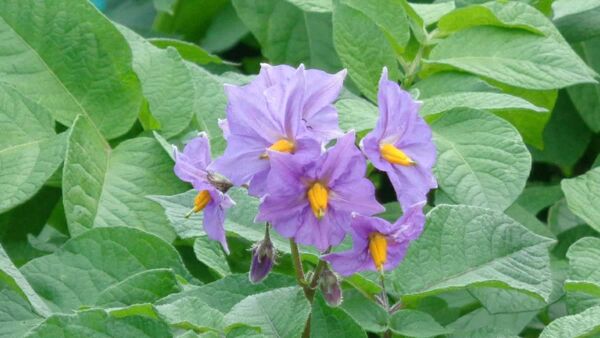The humble spud has always served us well

David Langford, from Killasser, Swinford, with some of his collection of rare, unusual and heritage potatoes. Picture: Henry Wills Archive
My fingers aren’t very green but I find at this time of year, I have a yearning to get out and start digging. Maybe it’s the warmer days or the stretch in the evening, or maybe it’s some primeval instinct, but I just have to get the spade and head for the garden.
I have often heard it said that anything started on Good Friday is sure to be a success, so taking that piece of advice, each year I make a few potato drills for planting. Over the years, I have had minimal success with my crops but I always manage to get a few dinners for my efforts and those few spuds are the most delicious.
Despite wet ground conditions and an early Good Friday this year, I feel the same urge coming over me and this spring, I will try again. This year also, I am interested in finding out a bit more about the humble spud; how it got here in the first place and how come it has such a wide appeal.
A quick trawl throws up a few interesting facts right away. The potato was domesticated in the South American Andes some 8,000 years ago and, after rice, corn, wheat, and sugar cane, it is the fifth most important crop in the world.
In 1536, Spanish Conquistadors in Peru discovered the pleasures of the potato and transported them to Europe. At first, the potato was not widely accepted. Sir Walter Raleigh introduced potatoes to Ireland in 1589, but it took another 50 years for the potato to spread to the rest of Europe.
Diego Arguedas Ortiz, writing for the BBC in 2020 on takes us back to the origins.
Diego explained that potatoes were domesticated high in the Andes, near Lake Titicaca, nearly 1,000km south-east of Lima. Following domestication, these early potatoes spread through the cordillera and became a crucial food supply for indigenous communities, including the Inca people.
It seems when the potato came to Europe, it was in for a bit of a shock. The Andean varieties had a tough time adjusting to life in Spain and other parts of mainland Europe. Day length is very constant across the year in the equatorial region where potatoes were first domesticated, so the potato plant was used to regular days with 12 hours of sunlight. Ortiz continues with the story.
While the potato found a ready-made home in Ireland, it also created a massive dependency in a country which was poverty-stricken and over-populated. Although the potato grew easily and bountifully, it had one failing; it was susceptible to disease. A piece written in in 1997 by Brendan McWilliams, , outlines the origin and the spread of potato blight.
An over-dependent population and a vulnerable crop was a disaster waiting to happen. Blight needs warm and moist conditions. Ironically, the Irish climate, so suited to growing potatoes, also provided the perfect conditions for ruining the same crop. When disaster finally struck, the effects were devastating. The failure of the crop was compounded by the utterly inadequate response by the British Government which decided against any meaningful relief. The rest, as they say, is history.
Despite the tragic outcome, the Irish somehow maintained their love affair with the potato. I believe the Americans and the French and the British, and, of course, the Peruvians, feel the same way about the potato; that feeling of ownership, the great comforter, that flexible friend that has so many uses and never disappoints or lets us down – well, almost never.

My father was a great man for growing spuds. Of all his farming pursuits, it was probably his favourite. Each spring, he would plough and settle and stick and mould and manure. Each summer he would spray and spray and spray again. Each autumn he would dig and pick and pit. He grew about an acre of potatoes; twelve, four furrow ridges of about 100 yards in length. He had several varieties: Ambassadors, Champions, Kerr’s Pinks and Records. These varieties provided a selection of skin and flesh colours; the floury and the soapy. There were spuds for home use, spuds for sale, spuds for cattle and spuds for seed.
I know why my father was so fond of growing potatoes. The project provided infinite variety and it was highly productive. I think the food element was secondary to the pleasure of pointing a plough at the soil each spring and digging stalk after stalk of powerful spuds with his spade each October.
A thought: why not make a resolution to grow a few potatoes this spring, now that the sap is rising. Get a few seed potatoes in your local Garden Centre and plan a small garden; a drill or two at the side of your lawn or even just a growbag on the patio. Enjoy the sight of that first stalk peeping through, that first blossom above that lets you know there are potatoes below, and best of all, that first dinner.
One last thing; get genetically modified seed that resists blight… because spuds were never meant to be grown in Ireland.
At another time, we will look at the potato again and discover its value as a food item and its versatility in cookery.






